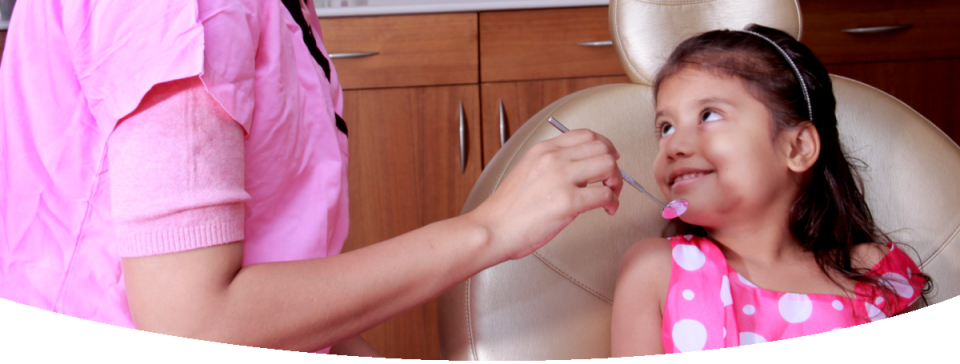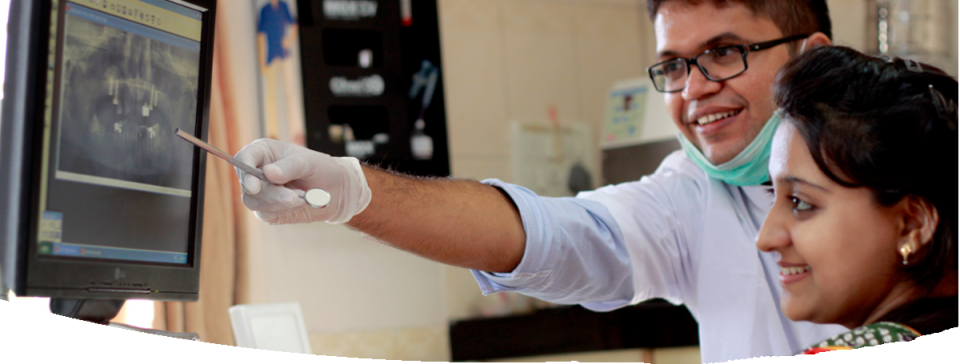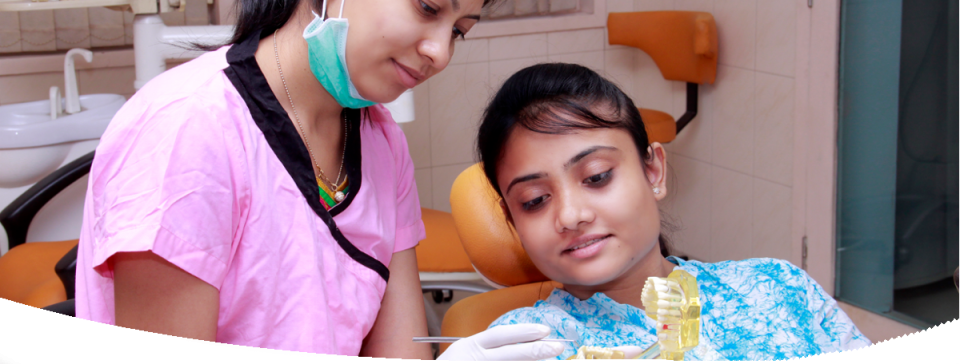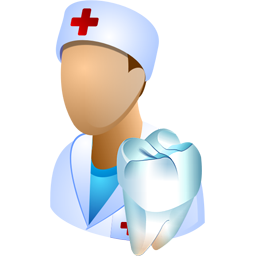Brushing your teeth properly at least twice a day helps prevent tooth decay and gum disease. Here are tips to proper brushing:

- 1. Brush your teeth for two to three minutes
- 2. Avoid hard scrubbing
- 3. Hold your toothbrush at a 45-degree angle and gently brush in short strokes from where the tooth and gum meet to the top of the tooth
- 4. Brush all outside and inside surfaces
- 5. Clean the pits and crevices on the chewing surface of your teeth with short sweeping strokes
- 6. Brush your tongue to remove bacteria and freshen your breath
- 7. Talk to your dentist about proper brushing techniques
Flossing technique
How to Use Dental Floss

You’re flossing. Great. But in order for dental floss to effectively remove plaque from your teeth, you need to be sure you’re using the correct technique.
Because you’ll be putting your fingers into your mouth, be sure to wash your hands before you reach for the floss. Then just follow these steps:
- 1. Use enough floss. Break off a piece about 18 inches long. That sounds like a lot, but you want enough to keep a clean segment in place as you move from tooth to tooth. Wrap most of the floss around either the middle finger or the index finger of one hand, whichever you prefer and a small amount onto the middle or index finger of the other hand. (Using the middle finger leaves your index finger free to manipulate the floss.)
- 2. Slide between teeth. Gently slide the floss between the teeth in a zigzag motion and be careful not to let the floss snap or “pop” between teeth.
- 3. Form a “C”. Make a C shape with the floss as you wrap it around the tooth. Then carefully pull the floss upward from the gum line to the top of the tooth.
- 4. Roll along. As you move from one tooth to the next, unroll a fresh section of floss from the finger of one hand while rolling the used floss onto the finger of the other hand. Use your thumb as a guide.
- 5. Reach both sides. Don’t forget to floss the back side of each tooth.
As long as you use the correct technique, the type of floss you use is a matter of personal preference. There are many types to choose from, and you can even choose a variety of types to meet your needs and those of your family members. Either way, using the correct technique will help you remove the excess food particles and plaque buildup between your teeth and help improve your oral health.
Mouthwashes

If you’d like to add a mouthwash or rinse to your oral care routine, it’s important to be aware of just what a mouthwash or rinse does. Some freshen breath, others provide an anti-cavity benefit from fluoride, while others contain germ-killing ingredients to help prevent plaque buildup.
You have many options and the right mouthwash or rinse for you is the one that meets your dental hygiene needs for the health of your teeth and gums and taste preference.
To help choose the right rinse, keep these points in mind:
To help choose the right rinse, keep these points in mind:
- 1. Alcohol—yes or no? Alcohol is a component of many mouthwashes and rinses, which can problematic if a large quantity is deliberately swallowed. If you want to buy one type of mouthwash or rinse for the whole family and your household includes school-aged children or teens, you may want to choose from the alcohol-free mouthwash products that are available. Also, some recovering alcoholics avoid mouthwash with alcohol because of the potential for abuse.
- 2. Sensitivity. Some people find the ingredients in mouthwash irritating, especially people who have sensitive gums. Also, people who don’t usually complain of sensitive gums may find that their mouths are more sensitive for a short time if they are recovering from a dental procedure. If you have a sensitive mouth, consider an alcohol-free or natural mouthwash. Natural mouthwashes often contain ingredients such as aloe vera and chamomile for a soothing effect.
- 3. Plaque control. If you want a mouthwash that not only helps control bad breath but also helps to prevent plaque buildup on the teeth, look for a dental rinse that contains anti-plaque ingredients.
If you’re uncertain about which mouthwash or rinse would best meet your oral health needs, ask your dentist or dental hygienist for suggestions.
6 Monthly Checkups
A checkup and cleaning twice a year may seem like a lot for someone with good home care and oral hygiene. But when you take into consideration the amount substance with sugar we eat daily, the accumulation of buildup can be significant in a six month period. Even with excellent home care (brushing, flossing, mouth rinse), there can be areas under the gum line next to the teeth that toothbrush bristles and flossing can’t properly reach without the equipment in the dental office.
Without this checkup, bacteria and tarter can buildup on the tooth surface and cause unpleasant symptoms resulting in cavities or even root canals, if left untreated.
Prevention is the number one reason for regular dental visits, dental disease can often be linked to other health issues, and without proper screenings and checkups, and these can go undiagnosed.
Care for children’s’ oral health
Healthy teeth are important for child’s overall health. From the time child is born, there are a lot of things you can do to make your child teeth healthy teeth and also to prevent cavities. Preventive dental care in early age is important throughout life, especially at a young age because to handle issue related to dental in this age is quite easy as compare to handle it after words.
You need to take proper care for your child to maintain oral health like,
- 1. Baby’s teeth should be clean by the soft and clean cloth or baby’s toothbrush (make sure that the brush should be soft)
- 2. Make sure your child brushes her teeth at least twice
- 3. Use toothpaste that content fluoride so that food particles and plaque will be removed from the tooth surfaces. Even be sure your child brushes the top surface of tongue also as it will help in keeping breath fresh.
- 4. You can also use a mouthwash to help kill bacteria and freshen her breath and even it will help remove plaque and food particles from between the teeth and under the gum line.
- 5. Take proper care of your child’s diet and try to avoid all stuff which content extra sugar.
- 6. Do checkup on regular bases.
Periodontal Problem
Acute periodontal problems require an accurate diagnosis, so that appropriate emergency care can be provided to relieve the patient’s symptoms of pain. Careful follow-up of the affected areas is essential for the avoidance of recurrent problems, which can lead to further soft and/or hard tissue destruction
Smoking Effects on Dental Health

Many studies have proven the ill effects of smoking on your overall health. Smoking increases your chances of having a heart attack or stroke and is a leading cause of lung cancer. Smoking while pregnant has also been linked to premature babies and birth defects.
This probably isn’t news to you. But did you know that smoking also greatly affects your teeth, gums, and jawbone and mouth tissues?
There are several ways that smoking ruins your oral health:
Tooth Stains — Smoking causes tooth stains or overall tooth discoloration. Teeth whitening or veneers can reduce or remove the staining — at the smoker’s expense. You’ll save money by not smoking at all.
Bad Breath — One of the main causes of halitosis is smoking. Not only does smoking give you dry mouth, but tar and nicotine settles in your oral cavity, leading to a condition known as “smoker’s breath.” Gum disease, another consequence of smoking, also causes bad breath.
Tooth Decay — Smoking increases the amount of dental plaque in your mouth and the more dental plaque, the harder it is to remove. This eventually leads to a dental tartar and tooth decay.
Gum Disease — Tobacco interferes with the function of gum tissue cells. Gums become damaged by separating from the bone, leaving them open to infection. Smokers are several times more likely to get advanced periodontal disease than non-smokers, increasing their need for ongoing gum disease treatment.
Tooth Loss — Advanced periodontitis eventually leads to bone deterioration and tooth loss.
Bad Breath — One of the main causes of halitosis is smoking. Not only does smoking give you dry mouth, but tar and nicotine settles in your oral cavity, leading to a condition known as “smoker’s breath.” Gum disease, another consequence of smoking, also causes bad breath.
Tooth Decay — Smoking increases the amount of dental plaque in your mouth and the more dental plaque, the harder it is to remove. This eventually leads to a dental tartar and tooth decay.
Gum Disease — Tobacco interferes with the function of gum tissue cells. Gums become damaged by separating from the bone, leaving them open to infection. Smokers are several times more likely to get advanced periodontal disease than non-smokers, increasing their need for ongoing gum disease treatment.
Tooth Loss — Advanced periodontitis eventually leads to bone deterioration and tooth loss.








